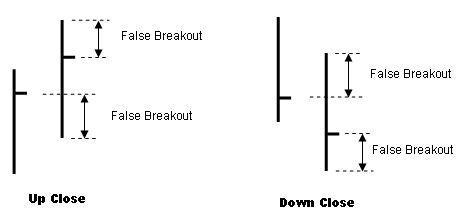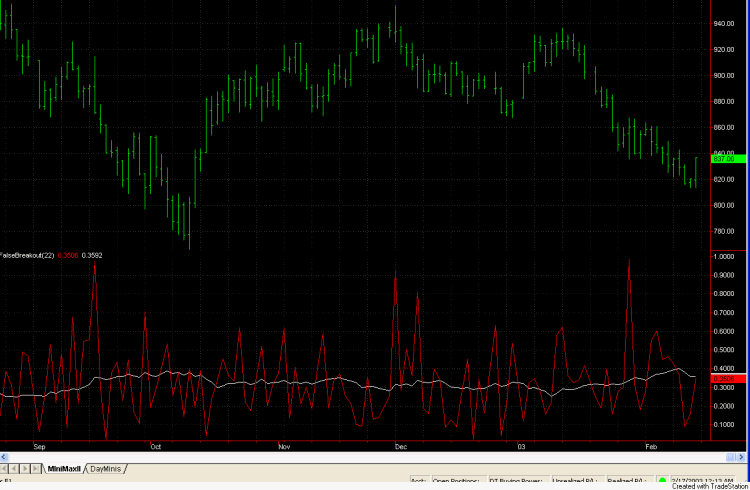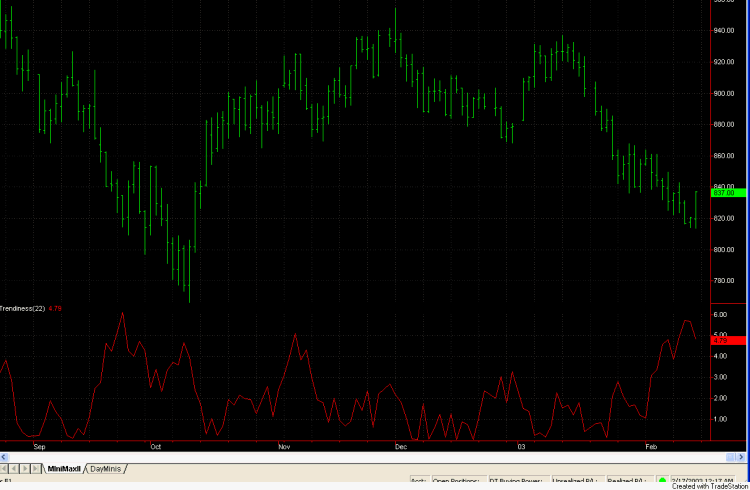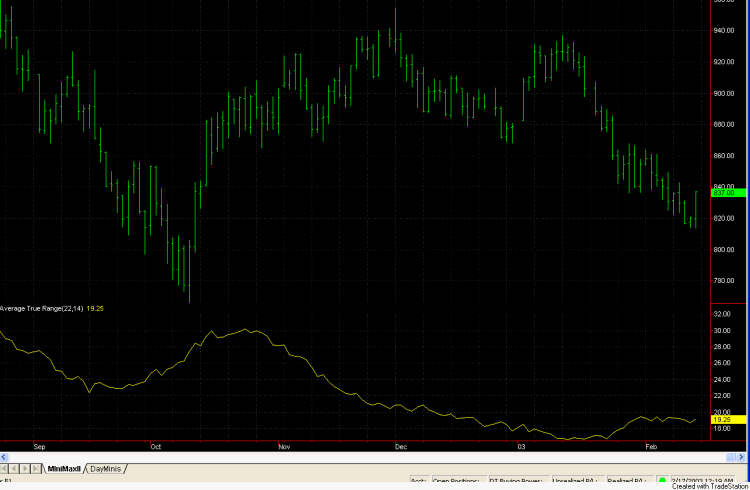Was
January Unusual?
I spoke with several
traders in February who remarked that the market seemed to be trading
differently (and not "good" different). The consensus seemed to be
that the worries about war with Iraq were affecting the markets and making
them more difficult to trade. This made me wonder if there was a way
to quantify the apparent changes in market behavior. Towards this end, I
looked at several indicators that represent
market dynamics.
False Breakout
Indicator
To get a better feel for the
extent of false breakouts recently, I came up with an indicator that quantifies
the size of the false breakouts, if any, on each bar. I define a false breakout
as the amount the market moves in the direction opposite to the direction
in which the bar eventually closes or the amount the market moves beyond
where it eventually closes. Specifically, on an up bar, I define a false
breakout as the amount that the market drops below the prior close or rises
above the current close, whichever is larger. Similarly, on a down bar, the
false breakout is the amount the market rises above the prior close or drops
below the current close, whichever is larger. This is illustrated in Fig. 1. A
bar that closes at the high or low of the day and has no trading overlapping the
prior close would have a zero value of the false breakout. To create the
indicator, I plot the raw value on each bar normalized by the average true
range and the moving average of this value. ("Range" is simply the bar's high
minus it's low; "true range" is similar but takes gaps into
account.)

Fig. 1 Defining "false
breakouts" for the FalseBreakout indicator.
The EasyLanguage code for the
FalseBreakout indicator is shown below.
{
Indicator: FalseBreakout
This indicator
calculates the size of the false breakout
on each bar (if any). It
normalizes the result by the
average true range and plots the raw
value plus the
average.
Michael R.
Bryant
Breakout Futures
www.BreakoutFutures.com
Copyright 2003 Breakout
Futures
Feb 11, 2003
}
Input: N (10);
Var:
FBO (0),
AFBO (0);
If C >= C[1] then
FBO = MaxList(H - C, C[1] -
L)
else
FBO = MaxList(H - C[1], C -
L);
FBO = FBO/Average(TrueRange, N);
AFBO = Average(FBO,
N);
Plot1(FBO, "False B/O");
Plot2(AFBO, "Ave
B/O");
Fig. 2 shows what this looks like
on daily bars for the E-mini S&P over recent months. While the daily value
is quite volatile, the average value doesn't change much over time, suggesting
that there have been no more false breakouts recently than in the past. While my
subjective impression was that there were more false breakouts in January than
usual, this is not supported by the false breakout indicator.

Fig. 2. FalseBreakout
indicator plotted on a chart of daily bars of the E-mini
S&P.
Trendiness
Indicator
A common way to define the
strength of the market trend is to divide the absolute value of the change in
price by the average true range over the past N bars. This tells us how much the
market has moved relative to the average true range. A market that's moved three
times the average true range over the last month has a stronger trend, for
example, than one that's moved only 1.5 times the average true range.
In EasyLanguage, this can be
written as follows:
Input: NBars (30);
Value1 = AbsValue(C -
C[NBars])/Average(TrueRange, NBars);
Plot1(Value1, "Trendiness");
In Fig. 3, this indicator
("Trendiness") is plotted on a chart of daily E-mini S&P data using a
look-back period of 22 days, the average number of trading days in a month. The
indicator looks particularly flat during December and January, two difficult
months for the short-term trading approach of the MiniMax II system. In fact,
the indicator only briefly got above a value of 3 over this 2-month period. The
last time the indicator was consistently this low was over the Dec-Jan
period one year earlier. Interestingly, MiniMax II was modestly profitable
during that period. The lack of trend strength may be a distinguishing factor in
the recent Dec-Jan trading period. However, it's not entirely clear that lack of
trend strength correlates strongly with lack of good trading opportunities.

Fig. 3. Trendiness
indicator plotted on a chart of daily E-mini S&P data.
Average True Range
Indicator
The last indicator I want to
examine is the average true range. In Fig. 4, the average true
range (ATR) is plotted for the daily E-mini S&P using a look-back
period of 22 days. In my opinion, this is the most striking of the three
indicators. The ATR hit a low of 16.7 (E-mini S&P points) on Jan 14th and is
currently hovering around 19. This is the lowest value since Mid-April 2002 and
is nearly half the value we saw in mid-October and early August. The ATR has
been trending steadily downward since mid-October, only recently appearing to
bottom out in January. While the trading volume of the E-mini S&P is about
as high as ever, the daily ranges have been contracting. One possible
interpretation of this is that it represents a lack of conviction among
investors and traders. Whatever the reason, it raises several questions. Is the
lack of volatility temporary? If it persists, how will it affect trading? Is
there a way to compensate for it? I try to address the last question below.

Fig. 4. Average true
range plotted on a chart of daily E-mini S&P data.
Dealing With Declining
Volatility
In this section, I present two
methods to adapt a trading system to market volatility. These methods --
the second one in particular -- are best suited to breakout
systems, although they may be worth investigating for other types of systems as
well.
Cycles of
Volatility
In the
November issue of
this newsletter,
I discussed using the ATR as a filter for a simple breakout system. The idea is
based on the observation that the ATR is mean reverting; that is, it tends to
move back to its average value if it gets too far away from it. If the ATR is
low, it will most likely move higher over the next few bars, and vice-versa if
the ATR is high. This suggests that if you wait until the ATR is low, a breakout
trade entering on the next bar has a better chance of developing into a nice
trade. I demonstrated that at least for the simple system I presented, using the
ATR in this manner helped improve the overall performance.
An even better way to take advantage
of cycles of volatility is to use the product of volume and ATR. I refer to this
product as the "activity." For example, a day with a large range and lots of
volume is arguably more "active" than a day with the same range but low volume.
Similarly, a day with high volume but a low range is less active than a day with
the same volume but a large range. To provide a "trigger" level, I take the
average of the activity over the last N days. Because the activity is
mean-reverting, if the activity is below its average, the activity can be
expected to increase over the next few bars. This can be used as an
entry filter to help restrict your trading to more active days.
Specifically, look for a breakout on the next bar if the activity on the
current bar is below its N-bar moving average.
In EasyLanguage, this filter can be
written as follows:
Var:
NAct (30), { look-back
period for activity indicator }
ActInd
(0); { value of activity indicator }
ActInd =
TrueRange * Volume - Average(TrueRange * Volume, NAct);
If ActInd
< 0 then
{
Place the entry order here; e.g., Buy next bar at H stop;
}
I've tried this filter on several
different breakout-type system, and it improved the performance in each case. It
might be worth trying with your own system.
Adapting the Breakout Amount
to Volatility
A classic entry method is to enter
on a breakout from yesterday's high, low, or close by an amount given by a
multiple of the prior day's range or average range. For example, you might take
50% of yesterday's range, and add it to yesterday's high to define your long
entry price. Since the amount of the breakout is a multiple of the range, this
method inherently adapts to the market's volatility, as defined by range or true
range. However, there's no rule that says this type of simple, linear function
of volatility is an adequate way to adapt the size of the breakout to
the volatility. For example, if low volatility is an indication of lack of
conviction by traders, we might expect that we'll get more poor quality trades
in a low-volatility market as the expected trends fail to materialize. This
is probably what happened to the MiniMax II system in January. Under these
conditions, we might want to increase the size of our breakout when the market
declines in volatility in order to raise the threshold for entry and avoid
trades in a trendless or reversal-prone market. However, this is exactly
the opposite of what will happen when we take our breakout based on a simple
fraction of the true range or ATR. Basing the breakout on a simple fraction of
the true range or ATR results in smaller breakouts as the volatility
declines.
Here's one possible solution.
Instead of taking a breakout as a simple fraction of volatility, make the
fraction a linear function of volatility, with a larger fraction at low
volatility and a smaller fraction at high volatility. The breakout itself is
still calculated the same way, by multiplying the ATR or true range by the
fraction. However, the fraction will vary with the ATR.
As a baseline for comparison,
consider the simple breakout system below:
Input: EntFrL (1.0), {
Volatility multiplier for entry }
EntFrS (1.0), { Volatility multiplier for entry
}
MMFrL
(2.0), { Volatility multiplier for exit
}
MMFrS
(2.0); { Volatility multiplier for exit }
Var:
ATR (0); { average true
range }
ATR =
Average(TrueRange, 22);
Buy next
bar at H + EntFrL * ATR stop;
Sell short next bar at L - EntFrS * ATR
stop;
If
MarketPosition = 1 and C > EntryPrice and BarsSinceEntry >= 1
then
Sell this bar at close;
If
MarketPosition = -1 and C < EntryPrice and BarsSinceEntry >= 1
then
Buy to cover this bar at close;
If
MarketPosition = 1 then
Sell next bar at EntryPrice - MMFrL
* ATR stop;
If MarketPosition = -1
then
Buy to Cover next bar at EntryPrice + MMFrS * ATR
stop;
This system enters on a breakout
from the prior high/low using a fraction of the 22-bar ATR as the amount of the
breakout. It exits on the first profitable close after at least one bar
if not stopped out at the exit stop given by a fraction of the ATR from the
entry. Using 1410 min bars of the E-mini S&P (symbol @ES in TS 6; a
1410 min bar represents one day), I optimized the inputs over the last 500 days.
I found the following input parameter values worked well: EntrFrL =
0.4, EntrFrS = 0.3, MMFrL = 0.6, and MMFrS = 1.9. The one-contract results using
these inputs were as follows ($75 per contract has been deducted for trading
costs):
Net Profit: $16,863
No. Trades: 155
% Winners: 68%
Ave. Trade: $109
Profit factor: 1.39
Max Drawdown: -$6,038
We'll take these as the
baseline results without the variable breakout fraction. Now consider the system
with the variable breakout fraction.
Input: FrLv0 (.8),
{ Breakout fraction, low vol, longs }
FrLv1
(.3), { Breakout fraction, high vol, longs
}
FrSv0
(.8), { Breakout fraction, low vol, shorts }
FrSv1
(.3), { Breakout fraction, high vol, shorts
}
MMFrL
(2.0), { Volatility multiplier for exit, longs
}
MMFrS
(2.0); { Volatility multiplier for exit, shorts }
Var:
ATR (0), { average true
range }
ML (0), { slope of
b/o fraction curve, longs }
BL (0), {
y-intercept, longs }
MS (0), { slope of
b/o fraction curve, shorts }
BS (0), {
y-intercept, longs }
V0 (16), { low volatility
}
V1 (30), { high volatility
}
FrL (0), { entry fraction
for longs }
FrS (0); { entry fraction
for shorts }
ATR =
Average(TrueRange, 22);
ML = (FrLv1 - FrLv0)/(V1 - V0);
BL =
FrLv0 - ML * V0;
MS = (FrSv1 - FrSv0)/(V1 - V0);
BS = FrSv0 -
MS * V0;
FrL = ML * ATR + BL;
FrS = MS * ATR +
BS;
Buy
next bar at H + FrL * ATR stop;
Sell short next bar at L - FrS * ATR
stop;
If
MarketPosition = 1 and C > EntryPrice and BarsSinceEntry >= 1
then
Sell this bar at close;
If
MarketPosition = -1 and C < EntryPrice and BarsSinceEntry >= 1
then
Buy to cover this bar at close;
If
MarketPosition = 1 then
Sell next bar at EntryPrice -
MMFrL * ATR stop;
If MarketPosition = -1 then
Buy
to Cover next bar at EntryPrice + MMFrS * ATR stop;
This system uses a simple linear
equation to calculate the breakout fraction as a function of ATR. ML
(MS) and BL (BS) are the slope and "y-intercept" of the linear
equation for long (short) trades. Instead of a single value of the breakout
fraction as a system input, this system uses two values: FrLv0 (FrSv0) and
FrLv1 (FrSv1) for long (short) trades. The first parameter
is the value of the breakout fraction at low volatility, and the second
parameter is the value of the fraction at high volatility. I've somewhat
arbitrarily defined "low" and "high" volatility as ATR values of 16 and 30,
respectively (variables V0 and V1). The exit logic is identical to the baseline
system above.
I left the exit parameter
values the same as in the baseline system: MMFrL = 0.6 and MMFrS =
1.9. I couldn't find any better parameters for the short side than the 0.3
value that worked well in the baseline system, so I used FrSv0 = FrSv1 =
0.3. However, for the long side, I found that the parameters FrLv0 = 0.5
and FrLv1 = 0.4 worked well. Compared to the baseline system, the only
difference is that the breakout fraction for long trades varies between 0.5 when
the volatility is low to 0.4 when the volatility is high.
With this one change, the
one-contract results over the same period of time as for the baseline
system are as follows ($75 per contract has been deducted for trading
costs):
Net Profit: $21,300
No. Trades: 141
% Winners: 72%
Ave. Trade: $151
Profit factor: 1.55
Max Drawdown:
-$6,650
Increasing the breakout fraction
under conditions of low volatility improves the performance of this system on
the long side of the market. The improvement appears to results from filtering
out 14 trades that the baseline system took. This is consistent with our goal of
avoiding poor trades during periods of low volatility. This idea may be worth
testing on other systems and markets. One drawback is that you introduce extra
input parameters. However, as long as any parameter optimization is performed
over a large number of trades, as in the examples here, the risk of over-fitting
the system to the market is minimal. As with any trading approach, it's probably
a good idea to test it in real time before committing capital.
In summary, the markets have
exhibited declining volatility in recent months. While this lower volatility may
cause problems for some short-term trading systems, there may be ways to
mitigate the damage. Hopefully, you'll find one or both of the ideas I've
discussed here worth investigating for your own trading. That's all for
now.